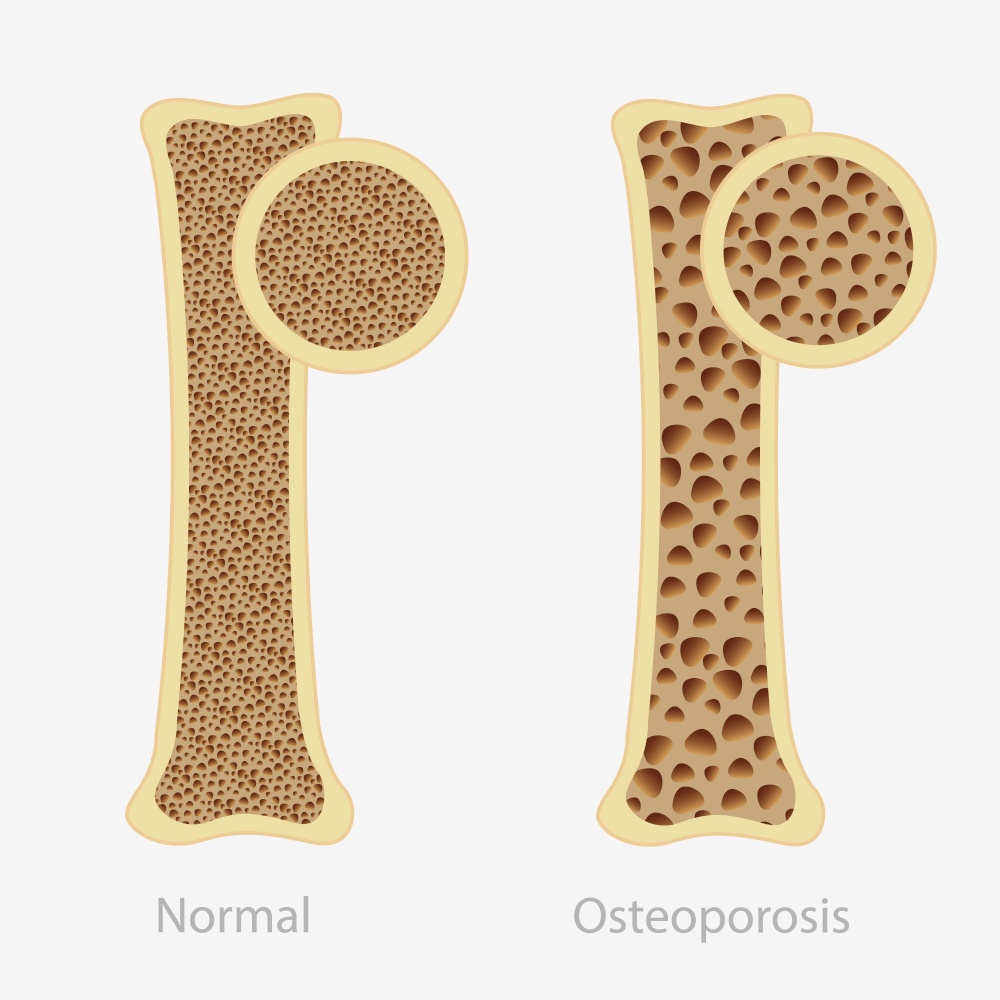There is a hole in the bone?
This disease is nicknamed “Silent Disease” because it progresses without symptoms in the beginning but is often found only after a fracture appears.


What is osteoporosis?
“Osteo” means bone, “Porosis” means porous. And “Osteoporosis” means that there are many holes in the bone, and “osteoporosis” refers to a disease that tends to cause fractures because the amount of bones decreases and the strength of the bones weakens due to qualitative changes.
In other words, it refers to a state in which the amount of bone is significantly reduced compared to the normal person, and the strength to withstand weight or mechanical pressure is weakened, and a common metabolic disease that causes bone to fracture easily even with a slight impact such as a light fall.
Who does it happen a lot?
Bone mass increases from puberty to the early 30s, and then begins to decrease gradually. Bone mass gradually decreases from about 35 years of age, and in the case of women, bone mass decreases rapidly with menopause around age 50. About 30% of the elderly population is at risk for osteoporosis, and about 18% of women over the age of 60 experience a vertebral fracture at least once in their lifetime. At a ratio of 5:1, it is more common among women than men.
What is the cause?
- Calcium absorption problem: When calcium cannot be absorbed due to surgery to cut the stomach or chronic inflammation of the intestine.
- Vitamin D deficiency: Vitamin D deficiency increases the excretion of calcium, causing bone breakdown.
- Menopause: Menopause reduces estrogen, which can lead to osteoporosis.
- Lack of exercise: Weight-bearing exercises, jumps, and strength exercises are good for bone health.
- Family History: If the mother or sister has osteoporosis, it is more likely to develop.
- Heavy drinking: Excessive drinking reduces bone formation and reduces calcium absorption.
Are there any symptoms that indicate osteoporosis?
- Initially, there are no symptoms, or only general symptoms such as dull pain around the spine and frequent fatigue appear.
- As the disease progresses, your back will bend forward, and your height will decrease.
- Fractures can easily occur even if you fall lightly. In severe cases, bones can easily break even during daily activities, such as bending your back or coughing.
- Fractures occur well in the wrist and hip joints.
How is the diagnosis?
- As the most common method, it can be diagnosed early as below by DEXA (Dual Energy X-ray Absorptiometry) scan.
- If T-score is above -1: Normal
- If T-score is from -1 to -2.5: Pre-Osteoporosis, called Osteopenia.
- If T-score is below -2.5: Osteoporosis
How is the treatment done?
- Calcium intake: 1,000mg per day for adults and 1,200 ~ 1,500mg for over 50 years old is recommended.
- Vitamin D intake: When vitamin D is deficient, it is difficult to absorb calcium from the intestine, which causes calcium to escape from the bones. Vitamin D is made by sunlight or is absorbed through food. When taken as a supplement, it is recommended to consume at least 800 IU ~ 2,000 IU per day.
- Bisphosphonate: This is the most commonly used treatment, which is known to increase bone density and decrease fracture rate.
- Other prescription drugs: Calcitonin, estrogen, selective estrogen receptor modulators, and parathyroid hormone.
Progression?
Fractures are the most common and serious complication. Mainly, bones in the spine and hip joints are broken. When you fall, you often break the bones of your wrist while putting your arm on the ground.
Caution?
- Avoid excessive drinking and stop smoking.
- You must maintain bone mass by performing appropriate aerobic exercise and weight bearing exercise including balance training for fall prevention.
- Avoid salty foods and prevent the loss of calcium along with salt.
- If you eat a lot of caffeine, a lot of calcium is excreted through urine and feces.
- It is helpful to synthesize vitamin D by exposure to sunlight 2-3 times a week for about 15 minutes.
Foods to prevent osteoporosis
- Shiitake mushroom
Shiitake mushrooms are rich in vitamin D, which helps absorb calcium. In addition, the lecithin component clears the blood by removing cholesterol in the blood vessels and stabilizes blood pressure. - Milk
Milk, which is rich in calcium, is good for bones. It contains enzymes and other ingredients that help the immune system, making it an excellent osteoporosis prevention food. - Cheese
Cheese contains 1.5 times more protein than beef and 20 times more calcium than beef, helping to maintain the skeleton and prevent osteoporosis. - Anchovy
Anchovy is a calcium-rich food that helps prevent high blood pressure, colon cancer, and improve memory in addition to osteoporosis. - Nuts
Nuts such as walnuts and almonds and peanuts are rich in calcium, which strengthens bones, and magnesium, which helps absorb calcium. - Bean
Soybeans contain a lot of calcium and are good for middle-aged women because they contain a vegetable female hormone, isoflavones.
Yoon Park, MD
Family Medicine
Edmonds Medical Clinic